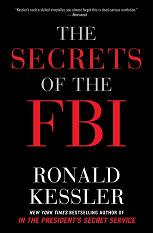
The Secrets of the FBI, by Ronald Kessler: Although rather defensive over some the FBI’s mistakes, it starts with Hoover and goes over some of the good and bad points of each director peppered with many humorous anecdotal tales of FBI break-ins gone wrong, like when a cat escaped and they sent agents with night vision out to recapture it, threw it back in the house and wondered why the dog was flipping out over the cat only to find out the next day that it was the wrong cat. Or the time a bus was parked in front of a house to give agents cover for a target house they broke into, after which everyone piled in the bus and drove off, only to find two freaked out pedestrian passengers who boarded without anyone noticing and was now ringing the bus stop bell to be let off the bus filled with black-suited men bearing weapons.

The More Than Complete Action Philosophers, by Fred van Lente and Ryan Dunlavey: A hilarious graphic novel that provides good synopses on ancient, medieval and modern philosophers, including: Thales of Miletus, Anaximander, Anaximenes, Heraclitus, Parmenides, Empedocles, Lao Tzu, Plato, Aristotle, Diogenes, Epicurus, Epictetus the Stoic, St. Augustine, Bodidharma, Rumi, Thomas Aquinas, Mchiavelli, Isaac Luria: Rabbi of the Mystic Arts, Descartes, Hobbes, Spinoza, George Brekeley, Leibniz, Hume, “Oh no, Rousseau!” sitcom, Jefferson, Immanuel Kant: Epistemological Attorney (God hires him after being indicted as a “transcendental illusion”), Georg Hegel vs. Arthur Schopenhauer, Auguste Comte, Soren Kierkegaard, Marx, “You’re a Good Man John Stuart Mill” Charle Brown comic, Nietzsche, William James, Freud, Jung, Ludwig Wittgenstein, Jean-Paul Sartre, Joseph Campbell, Ayn Rand, “The Foucault Circus,” and Derrida the Deconstructonator.
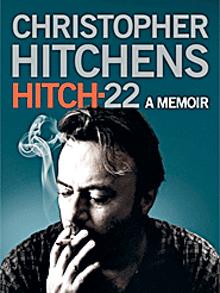
Hitch-22: A Memoir, by Christopher Hitchens: Turns out the priest Hitchens’ mother committed suicide with was an X-priest and they both had become initiated into a religious following by Maharishi Mahesh Yogi, the “Beatles Guru.” This, combined with the the way he had to pay a priest who was grumbling about the sanctity of deterring a suicidal adulteress has made me even more confident that his, and the unabashed love he described for his mother — descriptions which bordered so much on Oedipal that I thought I was listening to D. H. Lawrence — has made me more confident in connecting this to his hatred of religion.
Another weird thing is that although a great deal of the book is dedicated to his protest against Vietnam and his first encounters with associates and books in the world Socialist movement. Yet the only reason he gives for being against Vietnam is because the U.S. was aggressively bombing an agrarian state, with no mention of WW2, the French colonies, China, the Korean War, the South Vietnamese, or anything to put the war in context. One could make the same argument he gives for Iraq. In other words, the book has more to do with what he did than why he did it. He does the same thing with Kennedy, completely blaming him solely for the Cuban Missile Crisis as if it had more to do with the United States’ desire to annex a “Banana Republic” rather than prevent a nuclear buildup on it’s front door. No blame whatsoever for the U.S.S.R. (A later chapter says that a review of his work showed that the word he used was, quite surprisingly, not “Banana Republic” but “perhaps”.)
Although he gives some reasonable explanations for being against of the Gulf War, such as the U.S.’s role in the Iraq-Iran war and Bush originally pledging not to defend Kuwait being a signal that Saddam was going to be allowed to take the oil fields but not the country,
the way he moves from goes from opposing the Gulf War with quiet reservations to hating those who support the Iraq War in the same chapter is mentally disjointed, even falling into the same tropes that he would have found to be disgusting propaganda had it been used for the Vietnam war. Had the Gulf War been expanded into a 10-year ouster of Saddam, he no doubt would have felt as vindicated (something he says is the definition of happiness) as if the Iraq War lasted as long as the Gulf War. As it so happened, his transformation from World-Citizen Socialist to American Liberal Hawk coincided with his supporting of a bad war in the guilt of not supporting a good war. Especially strange is the way he insincerely suggests that the Bush Administration and his good pal Paul Wolfowitz were criminally negligent for the massive power outage that hit Iraq and the lack of properly issued vehicale and body armor following Saddam’s fall, yet he nevertheless compares Rumsfeld’s quote about “going to war with the army we have” to his own unconvincing belief that he would have pushed for the Iraq War had Gore been president. Thomas Jones says it best:
More striking than the way in which the content of his opinions has changed, however, is the continuity in the manner in which he has held those opinions. He likes to think of himself as a rational sceptic, but he isn’t really: his views are more visceral than that, his lurches from one deeply held position to the next driven mostly by gut instinct. Fine orator and fluent writer though he is, he’s never been much of an analytical thinker, and his style of argument proceeds more by a series of emphatic, emotive and stylish assertions (he magnificently denounces Argentina’s General Videla as looking ‘like a cretin impersonating a toothbrush’), by appeals to common sense and common feeling, than by logical reasoning.
Masterfully eloquent in his delivery, every appended anecdote scorched with dry British wit, it is very much worth the cost of not being able to interpret some of his phrases to listen to it on audiobook.
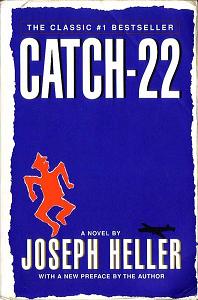
Catch 22, by Joseph Heller: I was given this book by a friend even though I wasn’t sure if I was going to read it, but was told by him that the book was so good he had a second copy just so he could lend one out. Apparently I took too long because the last time I was over at his place before the New Year, he announced (not to me specifically) that he had bought another copy of it. Haven’t gotten far in it but the theme of the WWII-set storyline seems to be that in a world gone completely insane, only those feigning illness to get out of the war are completely sane.

Fullmetal Alchemist, by Hiromu Arakawa: A story in a paralel universe where alchemy replaces science. Two brothers, Edward and Alphonse Elric, attempt to break alchemy’s ultimate taboo and use the art to bring back their dead mother. The act pulls Edward’s leg into another dimension while Alphonse is completely swallowed up. Waking up, Edward finds a tortured, half-constructed organ mesh where his mother should be and his brother gone. Using alchemy once again, he sacrifices his arm to anchor Alphonse’s soul to a body of armor. In grand steam punk style, his friend/love interest Winry then creates a metallic arm and leg for him, the first of which he often transforms into a blade using alchemy. Alphonse’s fearsome look is contrasted by his a polite, gentle character, and his disappearing memories later make him wonder if he really existed before he was transposed into the metallic body. Edward is shorter than average and a lot of comic relief comes from how extremely touchy he is about it, along with the running gag that everyone they meet naturally thinks that Alphonse is the “Fullmetal Alchemist.”
The manga reminds me a lot of Rumiko Takahashi, and she does say that Rumiko is one of her inspirations. Two different television series were born from the manga: the first one moves in a different direction once it catches up with the manga and the second one basically rewrites a bunch of the episodes for the first season and then continues with the manga telling of the story. I had watched the movie a couple of years ago even though and enjoyed it even though it acted as an ending for the first series. The movie was set in our own universe right before Hitler’s Beer Hall Putsch, with the plot involving the Nazi-connected Thule Society trying to open a portal into the other world.
As for the manga, it had a wonderfully massive ending that concluded the story. That is one thing I’ve always appreciated about the Japanese manga artist. They may have no problem carbon copying themes from every other manga/anime in existence (Negima!, for example, is a now-typical “harem” comedy about a 10-year-old magician with a talking ferret that has 31 schoolgirls “almost” kissing him, including: a ninja, a vampire, a robot, a ghost, a half-demon, a web idol, and a time traveling Martian). But for their lack of originality, the Japanese manga artist at least knows how to end a story and move on, whereas no cartoon in the U.S. can ever change anything on their last comic/episode on the chance it might get picked up again.

Hedge Knight II: Sworn Sword, by G. R. R. Martin. Before writing the stupendous Song of Ice and Fire series, Martin wrote for The Twilight Zone and the CBS drama Beauty and the Beast. Hedge Knight is the story of a not-too-bright knight-for-hire and his younger, bald squire, the literate but still childish “Egg.” Like Game of Thrones, Martin does a great job immersing the reader into his world and the lushly colored art is spectacular. As always, even the most minor of characters is an interesting three-dimensional medieval personality and the plot has plenty of great plot twists.
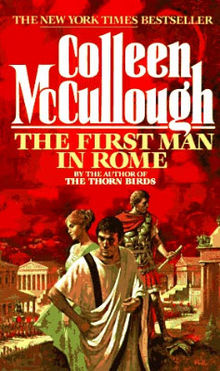
The First Man in Rome, by Colleen McCullough: This is the first in a series of extremely long novels, starting with the history of the Social War in first-century B.C. Rome and ending with Antony and Cleopatra. The first novel chronicles the lives of Gaius Marius, a powerful man without prestige, and Sulla, a nobleman without money or power before their alliance and eventual conflict, which eventually broadens out to the Social War between Rome and Italy, which in turn precipitates the Civil War between Caesar and the Republic. McCullough does a great job combining a character-driven novel with an amazingly immerse background in Roman history, complete with appended glossary. The immense novel lengths of McCullough is not the only thing she shares in common with George R. R. Martin. Like Martin, she gets the characterization right, masterfully blending modern psychological traits with ancient cultural mores.
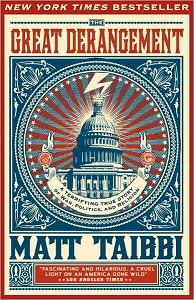
The Great Derangement: A Terrifying True Story of War, Politics, and Religion at the Twilight of the American Empire, by Matt Taibbi: Working under Rolling Stone, the only magazine that will allow Taibbi to say “FUCK YOU” to Mike Bloomberg, Matt goes undercover, pretending to be both a Fundamentalist Christian in one of John Hagee’s Megachurch cells and a 9/11 Truth follower to show how modern politics has polarized political groups into conspiratorial cults. Probably the only author I know who non-nonchalantly referred to himself as a drug addict without any explanation or elaboration. Taibbi is also surprisingly bad at his undercover roles, explaining that at one point he told his fellow Megachurch supporters that his Dad had died in some clown-related incident… and that wasn’t even something he came up with on the spur of the moment. The undercover work actually seems to yield very little in damning material about the individuals he meets, who you end up feeling sorry for more than anything, and so most of the book is him extrapolating on conversations he had with them in order to explain his own points. Surprisingly dull for such a talented writer.
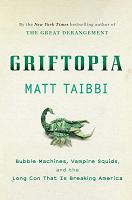
Griftopia: Bubble Machines, Vampire Squids, and the Long Con That Is Breaking America, by Matt Taibbi: A must-read for those looking into a non-partisan explanation of the financial crisis of 2008. He explains how the Tea Party was “top-down media con” initiated by CNBC’s Rick Santelli when he denounced not the huge bailout of the banks but rather the relatively small bailout for people facing foreclosure. (The name goes back to Ron Paul’s 2007 Boston Tea Party fund raising commemoration, but that’s like comparing the commercialized rape-fest of Woodstock ’99 to its original). He describes Alan Greenspan as an economist who became famous for being famous, a social ladder climber who got in with Ayn Rand to help himself get into elite circles and then abandoned her Libertarian philosophy to join the Federal Reserve as a corporatist. Taibbi explains how the banks repackaged securitized loans as Collateralized Debt Obligations (and in the process took the loan originators off the hook), then cut these bundled loans into “tranches”, convinced the rating agencies who depend on the banks for their living to give them a Triple A rating, and then insured them through credit default swaps so that neither sellers like AIG needed capitalization, nor buyers needed to own the insured assets.
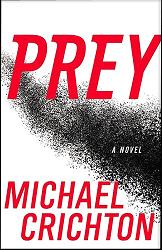
Prey, by Michael Chrichton: Nanomachines that are evolving into hive behavior begins killing the scientists who created them. The protagonist, an out-of-work scientist who helped develop the nanomachines but now a stay-at-home Dad, goes to the Nevada desert lab where his wife works to help bring them under control while at the same time worrying about whether his wife is having an affair with his former friend and team leader. Decent novel. Follows a kind of horror movie format. The science seemed well researched, as opposed to say, Timeline, where Chrichton emphatically maintained was based on parallel universes and NOT time travel before ending the story with the protagonist changing the past in his own timeline.

Next, by Michael Chrichton: This is the last novel that was published before Chrichton died. This story is about transgenic animals being given the powers of human intelligence and speech. Genetic companies wage legal and covert battles. One of the main characters, a biotech researcher, is forced to adopt a child-like chimp that has his genetic material and his wife creates a fictitious genetic disease on Wikipedia to explain his appearance at school. The family must deal with bullies and the genetic corporation trying to eliminate him to destroy evidence of unauthorized experiments. There are several other plot threads, some which run into the main one, and others that go nowhere and just die out, and Chrichton explains in an interview appended to the audiobook that he did this to emulate the way genes themselves evolve.
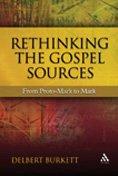
Rethinking the Gospel Sources: From Proto-Mark to Mark, by Delbert Royce Burkett: This book has been nothing short of revolutionary for me. I had of course, long believed that there was more than one earlier prototype for the Gospel of Mark, but Burkett’s theory made me change my mind on two things that I never would have believed possible: that the Griesbech Hypothesis was partially true and that Jesus’ resurrection appearance at the end of Mark’s gospel, which most modern Bibles now mark off as a late addition, is actually the original ending.
The Griesbach Hypothesis is a very old rival to the Two Source Hypothesis saying Matthew and Luke had used Mark. The theory instead argued that Mark’s gospel is actually a combination of Matthew and Luke. There was no shortage of evidence against the Griesbach hypothesis: Mark’s language was cruder, it’s plot less grandiose, and tons of gospel content would have had to have been exercised from Matthew and Luke for no discernible reason. I had studied the Griesbach Hypothesis for my thesis and wrote against one Griesbach author who had tried to show that Mark had been switching back and forth between Matthew and Luke as he went along. By looking at some of the examples, I showed that the “alternations” were ethereal: every instance of “Mark copying Luke” had some Matthean language in it and every instance of “Matthew copying Mark” had some Lukan language in it. But I rememeber thinking how weird it was that Matthew and Luke always seemed to take a different verse from Mark than the other.
As it turns out, that is because both the Two Source Hypothesis and the Griesbach hypothesis are true: Matthew and Luke had respectively copied from two different versions of Proto-Mark, called Proto-Mark A and Proto-Mark B, but Mark’s gospel itself was born of the incestuous union of those same two sources. The effect was that while Matthew and Luke had much longer gospels than Mark because they combined different stories, Mark had longer stories than Matthew or Luke because he combined verses from different versions of the same story. It was hard to believe at first: I typically assumed gospel variants expanded like branches on a tree: generally moving apart from one another, but this hypothesis showed that Proto-Mark had been expanded by two different authors and then later recombined back into Mark.
The second miracle, convincing me that both Proto-Mark and Mark actually had a resurrection appearance sequence at its conclusion, came from showing that Mark’s ending had material that came from both Proto-Mark A/Matthew and Proto-Mark B/Luke, meaning that either it came about from Mark’s combining process or it coincidentally went through the same exact process at a later date. I had already known that Mark’s ending referenced Luke, but that only made me assume that the ending was an attempt to harmonize the earlier gospel with Luke’s Presbyter tradition. Instead, it seems a later editor cut out Mark’s resurrection sequence, something I had only seen Biblical literalists believe. The absence of a resurrection appearance made sense for Proto-Mark because early Christians probably would have believed the resurrection would happen at the upcoming Apocalypse, not before it, or so it seemed. Burkett even showed that textual parallels within Mark’s second, shorter ending with the earliest version of Proto-Mark proved that it based on Proto-Mark’s ending, basically meaning BOTH endings involving the resurrection appearance are authentic.
Proto-Mark -> Proto-Mark A & Proto-Mark B -> Mark -> Mark with Deleted Ending -> Mark with Proto-Mark’s Ending
Proto-Mark A -> Matthew
Proto-Mark B -> Luke
But why would a Christian cut out the resurrection appearance and leave Jesus’ tomb empty at the gospel’s conclusion? I thought that the most likely explanation was that it was edited by a Gnostic since the Gnostics generally eschewed apocalypticism, perhaps as a reaction against the messianic failures of the Bar Kohba Revolt. And, as it turned out, I had already accepted the plausible explanation from Helmut Koester that Morton Smith’s Secret Mark was a third-generation gospel edited by a baptismal sect since both Matthew and Luke lacked a verse from Mark making a literary connection between baptism and martyrdom. I even built on Koester’s hypothesis: Secret Mark had a story very similar to the resurrection of Lazarus from John’s gospel following the bathing narrative and the Gnostic-themed second layer of John appeared to be Valentinian. There was a branch of Valentinians known as the Marcosians, named after their leader Mark, who also happened to teach about a second baptism of Christ for perfection apart from the baptism of Jesus for the forgiveness of sins. Who better to write a Gnostic version of the gospel centered on baptismal resurrection under the name Mark?
But it was not to be. Burkett dismissed the existence of Secret Mark for lack of evidence and an insufficient amount of material. I went back and started to review Secret Mark with a mind to contradict him, but as it turned out, a writing expert had recently determined it to be a forgery and an old Da Vinci Code-like novel had since been discovered telling of plot involving a forged “lost gospel” that had been “discovered” at the Mar Saba monastery near Bethlehem, the same monastery Morton Smith had “found” the letter supposedly written by Clement of Alexandria quoting Secret Mark. Ironically, I had originally been skeptical of Secret Mark, even writing to a Biblical scholar that the dishonesty and cynicism in the letter didn’t seem to reflect the personality of Clement (one of the few theologians I kind of liked), but got a reply that it did reflect him. The fact that “Secret Mark” made Jesus look gay and that Clement’s letter mysteriously disappeared soon after Smith “found” it also made me skeptical, but I started to question that skepticism when Bart D. Ehrman claimed to have talked to someone from the monastery who said they had seen it and knew how it disappeared (although Ehrman himself remained unsure). I finally accepted Secret Mark as real when I read Koester’s argument dismissing Smith’s assumptions that the resurrection story was historical and linked to actual homosexual magical rituals used by Jesus. Although Burkett didn’t even mention it, an examination of his work on Proto-Mark also destroyed one of the main pillars of Secret Mark: the scene of Jesus entering Jericho and then leaving the city without doing anything inside it, long assumed by Bible scholars to prove the story in Jericho from Secret Mark was edited out, which is shown by Burkett’s work to be a byproduct of Mark combining his two sources. Thus, a late layer of Mark is disproven by the same process proving no less than three earlier layers of Mark.

The Panarion of St. Epiphanius, Bishop of Salamis, translated by Philip R. Amidon, S.J. (Jesuit): Driven by jealousy for not making Barkett’s discovery myself, I attempted to prove that Marcion’s “Gospel of the Lord” constituted an editorial layer in between Proto-Mark B and Luke, but came up with mixed results. Before I knew about Epiphanius’ quotations from Marcion’s gospel, I had gone through Luke and bracketed out what I thought was an earlier Marcionite gospel that was canonized into Luke. Although I did find a few examples from Epiphanius of what I think are verses that pre-date Luke, a lot of the content missing from Marcion actually appears in Mark and Matthew, leading to troubling conclusion that some verses really were “cut out” as Tertullian and most biblical scholars assume, and not only that but cut out for no good reason (as even Epiphanius mentions). Weirdest of all is that Epiphanius’ version has the physical resurrection of Jesus after he himself said Marcion only believed in a spiritual resurrection.
Another conclusion I came to from the comparison is that I believe Proto-Mark did in fact have a copy of the Sermon on the Mount but chose to pepper his action-oriented gospel with a few references rather than copy the whole thing down. Most scholars, including Burkett, believe the Sermon comes from Q, but the “Blessings and Curses” from it are very different from the Cynic Wisdom teachings that make up Q, plus both Matthew and Luke place the sermon in the context of a mountain, proving that the Sermon’s source was not a “sayings gospel” like Q.
Games That I am Playing

New Super Mario Bros. Wii
This game is amazingly challenging for the Wii era of the casual gamer, not to mention a game that could be essentially classified as a “party game” since it can boast 4 players, but having multiple players in a Mario game is the very pinnacle of nostalgic gratification. Having a second player can prove advantageous since you can cooperate a times, such as jumping on your partner’s head to gain altitude, but it also often trips you up as players run into one another and accidentally killings are very common. Given that the challenge level is so high, one would expect Princess Toadstool/Peach should have been one of the four main characters, but opting to keep the nostalgia centered completely on Super Mario Bros. 1 (rather than 2), Player 4 is just a second clone of Toad in another color, which is pretty pathetic given the expanded array of Mario characters– even Luigi has a princess girlfriend I think. The final battle against Bowser is also engineered to bring back nostalgic memories of the original castle-battle of SMB1 where Mario had to run under the jumping Bowser and flip a switch that dropped him into a pool of acid below, though it is spiced up with a final final battle against a magically-enlarged King Koopa. The game is played with the WiiMote held sideways to emulate the controller of the 8-bit NES. However, the decision to do this is met with a massive design flaw:

The A button puts your character in a bubble, which is useful if you make a mistake and are about to die, but is excruciating when you accidentally hit it and are the only one alive on the screen, because it automatically takes you back to the beginning of the level with whatever power-ups you had lost. It’s also easy to accidentally hit the power button, which causes everything unsaved up to that point to be lost. Either one button or the other got pushed accidentally dozens and dozens of times and usually at the worst possible times.
Music That I Am Listening To

The Girl With the Dragon Tattoo: by Trent Reznor and Atticus Ross.
I had heard that Trent Reznor had gotten involved with another band called How to Destroy Angels, but I didn’t really like the grating, demonic noise that indeed seemed designed to rupture the conscious mind of some ethereal beings. As it turned out, Trent had gotten married and the project was centered on his Filipino wife, Mariqueen Maandig, who quit her band West Indian Girl and joined her husband and Atticus on creating “Angels.” As if Trent getting married wasn’t shocking enough, he also has a son. Like Devin Townsend, Trent seemed to have lost some of his inspiration with With Teeth and Year Zero when he decided to get sober, but then he teamed up with Atticus Ross to create the four-cd instrumental epic, Ghosts I-IV, my favorite Nine Inch Nails album to date. Although he had talked about making a sequel to Year Zero and Ghosts, Trent eventually decided that NIN should “go away for a little while” and went on his “Waving Goodbye Tour.” However, the two soundtracks he has done with Atticus Ross, The Social Network, and the 3-cd behemoth, The Girl With the Dragon Tattoo, are just sequels to Ghosts with another name on it. Beginning with a cover of “Immigrant Song” by Led Zeppelin and ending with a cover of the Bryan Ferry song, “Is Your Love Strong Enough?”, under the moniker of How to Destroy Angels, the movie is bound to bring Reznor and Ross far more commercial success than had it been released as a Nine Inch Nails album.

